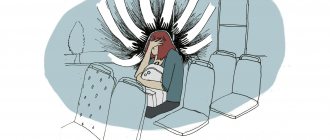Psychasthenic psychopathy or anxious (avoidant, evasive) personality disorder is a persistent change in character in which there is a constant feeling of inferiority, very high sensitivity to the assessments of other people, the need for social isolation and avoidance of active interactions with others. Patients see themselves as individualists and feel alienated. The need for distancing is explained by the lack of communication skills, the unattractiveness of one’s own personality, and the fear of being rejected or humiliated.
Contact our operator by phone 8(969)060-93-93 and sign up for a consultation.
Causes
The etiology has not been fully elucidated. Researchers believe that the disorder arises from the combined influence of predisposition, psychological and social factors. Among the genetic characteristics is the melancholic type of temperament, which is inherited, characterized by fearfulness, shyness and isolation when unusual circumstances arise.
Many patients have a history of prolonged criticism, rejection and rejection from parents, other significant figures, and their immediate environment. The need to maintain relationships does not allow one to completely break contacts with criticizing and rejecting people. At the same time, the inability to tolerate unpleasant emotions requires the formation of a powerful protective shell that limits the possibility of real intimacy, including with people who behave differently.
Thinking during psychasthenia
The thinking of psychasthenics is characterized by rationality. The actions of such people are always logical, never impulsive. I form my opinion (even on unimportant issues) by first assessing the pros and cons, trying to get to the bottom of the problem.
A psychasthenic’s demands on his person are always very high. For this reason, a person begins to consider himself worse than others according to the following indicators:
- intelligence
- comprehensive development
- work ability
- creativity
- strength of will
- physical development
- appearance, etc.
Psychasthenics have an inferiority complex.
Symptoms
The main signs are a constant need for social isolation, a persistent feeling of inferiority and an excessively high sensitivity to negative assessments of others. All of these manifestations arise in adolescence and adolescence, affect all aspects of life and are visible in a variety of forms. In addition, patients exhibit the following symptoms:
- Professional framework. The desire to avoid work that requires active communication, due to fear of rejection, condemnation, critical remarks from superiors, colleagues and clients.
- Limiting communication, refusing intimacy. A person does not want to contact others if he is not sure what will make them like him. He does not enter into close relationships because he has low self-esteem and is afraid of ridicule, shame or rejection.
- Socially conditioned experiences. The patient is often afraid of rejection or criticism during social interactions, feels inadequate and constrained if he has to immerse himself in new circumstances, one way or another requiring the presence of other people or communication with them.
- Distorted self-image. Existing difficulties and habitual patterns force the psychasthenic to interpret his personality in a special way in order to find explanations for his own behavior. He sees himself as "low quality", "wrong", unpleasant, or lacking and unable to obtain sufficient social skills.
- Refusal of new activities. A person avoids possible risks by any means, tries not to change the scope of application of professional skills, not to master new “spaces” (school, work, social), so as not to cause shame for his “otherness”, unsuitability, inadequacy, etc.
Optional but frequently occurring symptoms include an exaggerated fear of rejection, a high level of distrust of other people, a tendency to self-isolate, pronounced shyness, timidity and bashfulness. Patients usually have a good level of self-criticism and see the problem in themselves, rather than shifting responsibility for difficulties in relationships to others.
Social and professional difficulties, constant negative feelings cause a high probability of developing addictions. Receiving support is extremely difficult - patients experience rejection and personal loss so hard that they build an invisible wall around themselves and remain alone.
There is a tendency to constantly monitor one’s own reactions and the reactions of others within interpersonal contacts. The stress that arises from the need to keep track of all the details of interactions is sometimes so great that it interferes with free, unstructured speech, so patients may be laconic.
The psychasthenic type of psychopathy is often complicated by neurotic disorders of the anxiety spectrum. Agoraphobia, social phobia, simple phobias, panic attacks, generalized anxiety disorder are possible. There are indications that psychasthenia, as a character trait, is present in half of patients with obsessive-compulsive disorder.
What lies behind the terms neurosis and psychosis?
We are so used to throwing around the words “hysterical”, “neurasthenic”, “psychopath” that we often forget that we use medical terms as curses or even ridicule. Meanwhile, there is nothing funny in these words.
Neurosis
Neurosis can be briefly described as follows:
- This is nervous exhaustion, a long-term chronic disorder that can develop in a person against the background of stress or a traumatic event.
- The personality of a patient suffering from neurosis usually does not undergo major changes. The person maintains a critical attitude towards the disease; he can control his behavior.
- As a rule, neurosis is manifested by vegetative, somatic and affective disorders.
- This is a reversible (curable) disease.
The most common types of this disease are:
- neurasthenia (asthenic neurosis, fatigue syndrome);
- hysteria (hysterical neurosis);
- various phobias (fears, panic attacks) and obsessive states (obsessive neurosis).
One of the main reasons for the formation of neurosis is stress in the broadest sense of the word, be it a childhood trauma, an unfavorable climate in the family, a crisis at work, nervous strain, interpersonal conflict or emotional shock.
According to medical statistics, the state of neurosis is familiar firsthand to 10-20% of the population of our planet, and approximately 5% of the world's inhabitants suffer from various types of psychosis.
Psychosis
Speaking about psychosis, it is necessary to note the following:
- This is a mental disorder characterized by inappropriate human behavior and an atypical reaction to events and phenomena.
- It manifests itself as mental disorders, in particular, disturbances in the perception of reality (hallucinations, delusions).
- It develops unnoticed by the patient and may be a consequence of pathologies of the endocrine and nervous systems.
- Capable of completely changing the patient's personality.
- This is a difficult to cure disease.
Psychoses according to their origin are usually divided into:
- Endogenous , that is, associated with internal causes (somatic diseases, hereditary mental disorders, age);
- Exoorganic , caused by external factors (infections, intoxication, etc.) or associated directly with a violation of the structure of the brain (trauma, hemorrhage, neoplasms, etc.).
The first group includes:
- affective insanity;
- senile (senile);
- affective;
- schizophrenic;
- epileptic;
- symptomatic psychosis, etc.
The exogenous group includes:
- reactive acute psychosis;
- intoxication;
- infectious;
- alcoholic psychosis, etc.
1 Biofeedback therapy in the treatment and diagnosis of psychosis
2 Biofeedback therapy in the treatment and diagnosis of psychosis
3 Biofeedback therapy in the treatment and diagnosis of psychosis
Diagnostics
Diagnostic measures are carried out by a psychiatrist. The nature of the pathology is determined during the conversation. At the same time, the specialist studies the life history, evaluates the patient’s emotional reactions, his perception of comments and suggestions, and interpretation of certain life situations. Then a psychological and pathopsychological examination is carried out using special tests.
Psychasthenic psychopathy is differentiated from other personality disorders. The difference from sociopathy is social withdrawal, and not disregard for the rules and norms of society. Schizoids are characterized by the need to remain alone, while psychasthenics want communication, but avoid it out of uncertainty, fear of rejection and devaluation of their own personality. Dependent psychopaths suffer from the horror of separation, avoidant psychopaths suffer from the fear of forming contact.
Definition of the concept
Psychasthenia - what is it in psychology? Psychasthenia is a neurosis in which a person feels weakness of the soul. The name is derived from two Greek words: psyche, which translates as “soul”, and astheneia, which means “weakness”. The concept was introduced by the French psychologist Pierre Janet (1894).
The psychasthenic is constantly in a decadent mood and fear. He is sure that his character is dominated by shortcomings, so he tries to be invisible. He is afraid of excessive attention. And also the psychasthenic is afraid that someone will see through his weakness and see his flaws. At the same time, most of the shortcomings are exaggerated and far-fetched.
Important! Psychasthenics suffer from low self-esteem and an inferiority complex. They feel unnecessary and defective.
Cost of services
| CONSULTATIONS OF SPECIALISTS | |
| Initial consultation with a psychiatrist (60 min.) | 6,000 rub. |
| Repeated consultation | 5,000 rub. |
| Consultation with a psychiatrist-narcologist (60 min.) | 5,000 rub. |
| Consultation with a psychologist | 3,500 rub. |
| Consultation with Gromova E.V. (50 minutes) | 12,000 rub. |
| PSYCHOTHERAPY | |
| Psychotherapy (session) | 7,000 rub. |
| Psychotherapy (5 sessions) | 30,000 rub. |
| Psychotherapy (10 sessions) | 60,000 rub. |
| Group psychotherapy (3-7 people) | 3,500 rub. |
| Psychotherapy session with E.V. Gromova (50 minutes) | 12,000 rub. |
This list does not contain all prices for services provided by our clinic. The full price list can be found on the “Prices” , or by calling: 8(969)060-93-93. Initial consultation is FREE!
Signs
Signs of psychasthenia:
- uncertainty;
- fear of new things;
- doubts about any reason;
- slowness in speech and movements;
- psychological rigidity;
- total control;
- excessive self-criticism and self-demandingness;
- reduced performance and fatigue;
- introspection, turning into self-examination and self-flagellation;
- problems in the social and communication sphere;
- fantasy, abstract thoughts;
- suggestibility;
- health concerns.
Although psychasthenia is a mental disorder, many people live with it for years and are not even aware of the problem. Psychasthenia is taken as a character trait: simply weakness of spirit, gentleness, naivety, suggestibility. That’s why people don’t even try to change their lives, consoling themselves with the phrase: “I can’t do this, I’m not like that. I have no inner core." However, if you recognize the problem and work through it, you can radically change your life for the better, express yourself, build a career and family.
Note! A psychasthenic person is afraid of the negative consequences of his choice and is afraid of the future. If a person fails, he begins to “eat” himself even more and doubt himself even more.
Treatment
Therapy should be comprehensive, long-term, with an emphasis on non-drug methods. A good basis for psychotherapeutic work is created by providing conditions that help reduce anxiety at the body level. Patients need to improve their daily routine, organize their daily routine, ensure alternation of work and rest, and sufficient sleep. Moderate, but not excessive, physical activity and dosed new experiences that do not cause rejection or a desire to evade are useful.
Psychotherapy is carried out using various techniques. The most effective cognitive-behavioral methods involve identifying incorrect thinking algorithms, replacing them with more correct analogues, and then practicing to consolidate skills. Work begins in an individual format. In the future, group therapy is included to increase self-confidence within social contacts and practice new ways of interaction.
The most important role in achieving sustainable results is played by the therapist’s ability to gain and maintain the patient’s trust. If a specialist lacks this quality, a psychasthenic may begin to avoid work, for example, cancel sessions, making excuses for good reasons, or sabotage the process, distancing himself from the therapist, not showing him his thoughts and experiences.
If drug treatment is necessary, preference is given, whenever possible, to herbal preparations with mild hypnotic and sedative effects. In severe cases, it is possible to use traditional pharmacological agents, primarily antidepressants, which are prescribed in long courses. Tranquilizers play a secondary role; they are used short-term to quickly stabilize the condition and reduce the severity of side effects of antidepressants at the initial stage of therapy.
To schedule a consultation, dial the number 8(969)060-93-93.
How to treat
It is important for patients to maintain a certain regime, where a sufficient amount of rest is replaced by work activity. It is important to get rid of excessive stress and spend at least one hour in the fresh air. Doctors often include sleeping pills, foot massage treatments, special soothing baths, and general body massage in the treatment complex.
It is not recommended to spend a lot of time in the sun, as this can cause headaches of varying intensity, weakness and irritability. Among the effective psychotherapeutic methods, autogenic training is distinguished. In this case, it may be necessary to demonstrate the will of the patient himself, as well as to activate maximum forces in order to achieve a stable state of remission.
By developing special training, the patient learns to control breathing, is able to establish intellectual activity, gain power over the will, emotional state, and also be fully aware of all actions.
Regarding drug therapy, tincture of valerian and motherwort, as well as sodium bromide, is often used. The treatment process takes a lot of time, but work with the patient must be carried out in a comprehensive manner.









